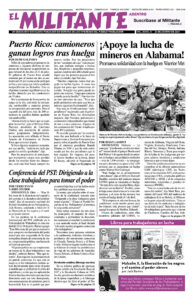Armando Choy Rodríguez, a brigadier general in the Revolutionary Armed Forces of Cuba, died July 26 in Havana at age 87.
Anyone who had the chance to meet Choy was struck by his pride and satisfaction of having devoted his whole life as a disciplined, conscious cadre in the revolutionary struggle to transform society in the interests of the exploited and oppressed.
His record as a revolutionary fighter is told in the book Our History Is Still Being Written: The Story of Three Chinese Cuban Generals in the Cuban Revolution, published by Pathfinder Press (see excerpts below).
Choy would often tell young people he spoke with that he — like most workers, peasants, and students who fought against the Batista dictatorship — didn’t get involved in order to make a socialist revolution. They fought for a land reform, to eradicate illiteracy, to uproot institutionalized racist discrimination, to provide jobs for all. But they had communist leaders of the caliber of Fidel Castro and Che Guevara who helped them learn from their own experiences as they in fact carried out a socialist revolution.
Choy was among the 425,000 Cubans who served as internationalist volunteers in Angola between 1975 and 1991, successfully defending that newly independent nation from multiple invasions by the white supremacist South African regime. Cuba’s contribution was decisive in also winning the independence of Namibia and in the fall of the apartheid regime itself — a turning point for Africa and the world.
Choy always pointed to how their participation in the Angola mission strengthened the Cuban Revolution. It helped deepen his proletarian internationalist consciousness and that of millions of other Cubans.
Choy was a founding member of the Communist Party of Cuba and of the Association of Combatants of the Cuban Revolution. In the 1990s and first decade of the 21st century he also carried central responsibilities as president of the State Working Group to clean up Havana Bay — a major environmental project.
In Our History Is Still Being Written the three Chinese Cuban generals — Choy, Moisés Sío Wong, and Gustavo Chui — describe the history of the 140,000 Chinese brought to Cuba as indentured workers on Spanish- and Cuban-owned sugar plantations, and their important role in Cuba’s 19th century wars of independence from Spanish rule and to abolish slavery and bonded servitude.
And they point to how in Cuba today, unlike any other country where large numbers of Chinese settled overseas, discrimination against Chinese Cubans has been eradicated as a result of the socialist revolution.
Copyright © 2005 by Pathfinder Press. Reprinted by permission.
[I got involved in the revolutionary struggle] as a student in Santa Clara. On the very day of Batista’s coup d’état, March 10, 1952, I opposed the coup and soon joined an anti-Batista organization.
I always say I’m a Fidelista going back to July 26, 1953. Because on that day, when the radio announced that Dr. Fidel Castro was the leader of the attack on the Moncada barracks, I said, “That’s the man we need to fight the dictatorship.”
I participated in student struggles and took part in street demonstrations, strikes, and other actions. I was jailed six times. At the beginning of 1958 I was named head of the July 26 Movement’s Student Front in Las Villas province. …
I went up to the mountains. … We had six combat engagements before being integrated into the column led by Commander Che Guevara in October 1958.
In December Che promoted me to captain and assigned me a platoon. I participated in a number of battles that contributed to the Rebel Army’s liberation of Las Villas province. That offensive culminated in the battle for Santa Clara, which ended on January 1, 1959, when Batista fled. …
The war to free Angola
In December 1986 [Cuba’s] Council of State named me ambassador to Cape Verde, a position I held until 1992. During that time, on Sal Island, which is part of the Cape Verde Islands, the agreement with the South Africans was reached following their defeat in the battle of Cuito Cuanavale. The essence of the 1988 agreement was that the South Africans would pull out of Angola for good, provided that Cuban armored units halted our advance before reaching the Namibian border and pulled back to a line north of the Cunene River, in southern Angola.
On the very day the Sal Island proposal was reached, the vanguard of General Enrique Acevedo’s tank brigade was practically at the Namibian border. The South Africans were in shock.
There was a second meeting at Sal Island a year or so later to review the implementation of the agreement. … At one point in the meeting, the head of our delegation, Carlos Aldana, turned to General Cintra Frías and said, “General, please tell [South African Deputy Foreign Minister] Mr. Van Heerden how much weaponry we’ve withdrawn.”
Polo gave the number of men, artillery pieces, and tanks — 800 of them. Van Heerden’s mouth dropped. He knew that even after that withdrawal, thousands of artillery pieces, tanks, other motorized vehicles, and men still remained with our forces in southern Angola. Clearly the South Africans would have been unable to stand up to that force. …
In 1992, at the Earth Summit in Rio de Janeiro, Brazil, our commander in chief, Fidel Castro, stressed the urgent need for taking measures to restore and protect the environment and thereby save humanity. …
The creation of the State Working Group for the Cleanup, Preservation and Development of Havana Bay is simply living proof that as we have conquered we’ve continued to develop.
This is possible because our system is socialist in character and commitment, and because the revolution’s top leadership acts in the interests of the majority of humanity inhabiting planet Earth — not on behalf of narrow individual interests, or even simply Cuba’s national interests.

